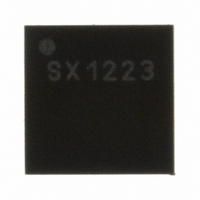SX1223I073TRT Semtech, SX1223I073TRT Datasheet - Page 8

SX1223I073TRT
Manufacturer Part Number
SX1223I073TRT
Description
IC TX UHF 433/868/916 MHZ 24TQFN
Manufacturer
Semtech
Datasheet
1.SX1223SK433.pdf
(25 pages)
Specifications of SX1223I073TRT
Frequency
425 ~ 475MHz / 850 ~ 950MHz
Applications
AMR, Home Automation, HQ Music and Data
Modulation Or Protocol
FSK
Data Rate - Maximum
153.6 kbps
Power - Output
10dBm
Current - Transmitting
25.8mA
Data Interface
PCB, Surface Mount
Antenna Connector
PCB, Surface Mount
Voltage - Supply
2 V ~ 3.6 V
Operating Temperature
-40°C ~ 85°C
Package / Case
24-TQFN
Lead Free Status / RoHS Status
Lead free / RoHS Compliant
Features
-
Memory Size
-
Other names
SX1223I073TR
4.1.2
4.1.3
frequencies corresponding to the transmission of the two possible values ‘0’ and ‘1’; these frequencies are then
separated by twice the specified single sided frequency deviation f.
The crystal oscillator (XCO) provides the PLL with the reference signal. The schematic of the crystal oscillator's
external components for 16 MHz is shown in Figure 2.
The crystal should be connected between pins XTA and XTB (pin 8 and 7). Either internal or external loading
capacitors for the crystal can be used. Internal capacitors can be enabled by setting the XCOcap_en bit to 1. Faster
start-up time is expected when using external capacitors. The total capacitance when XCOcap_en=1 (and no
external capacitors) is 9 pF. Using a crystal with a load capacitance of 9 pF will give the expected oscillation
frequency.
If XCOcap_en=0, the loading capacitors can be calculated by the following formula:
The parasitic capacitance is the pin input capacitance and PCB stray capacitance. For instance, for a 9pF load
crystal and a total parasitic capacitance of 6 pF the recommended values of the external load capacitors are 5.6 pF.
If an external reference is going to be used instead of a crystal, the signal shall be applied to pin 7, XTB. Due to
internal biasing, AC coupling is recommended for use between the external reference and the XTB pin.
The start-up time of the crystal oscillator can vary from 150us to 800us depending on the settings shown in Table
15. Therefore, to save current consumption, the XCO should be turned on before any other circuit block. During
start-up the XCO amplitude will eventually reach a sufficient level to trigger the M-counter. After counting 2 M-
counter output pulses the rest of the circuit is enabled.
Two bits are available to speed up the crystal oscillator start-up: XCO_high_I increases the bias current and
XCO_quick_start boosts this current but only at the start; the first output pulse from the M-divider turns this boost
current off. Typical values for XCO start-up time and current consumption are tablulated below:
A reference clock can be generated by SX1223 for use by an external microcontroller. The ClkOut_en configuration
bit determines the status of the CLKOUT pin. When set high CLKOUT is enabled, otherwise it’s disabled. When
enabled, the output frequency at CLKOUT is the crystal oscillator frequency divided by 16, and is then 1 MHz for a
crystal at 16 MHz. This clock signal is disabled in Sleep Mode. When disabled, the CLKOUT pin is set to ground.
The VCO is fully integrated and has no external components. It oscillates at 1.8 GHz and is divided by 2 or 4 in the
900 MHz or the 450 MHz band respectively (FreqBand = 1 or 0). Additionally two bits in the configuration registers
set the VCO frequency and three bits control the bias current. The two VCO_freq bits have to be programmed by
© Semtech 2007
Crystal Oscillator
VCO
Figure 2: External crystal oscillator circuit with additional (optional) external capacitances
XCO_quick_start, XCO_high_I
IDDST [uA]
TS_OS [us]
C
XTB, pin 7
L
5p6
C
1
1
1
Table 1: Oscillator start-up time
C
1
2
C
5p6
parasitic
XTA, pin 8
8
200
800
00
250
750
01
900
200
10
950
150
11
www.semtech.com
SX1223












